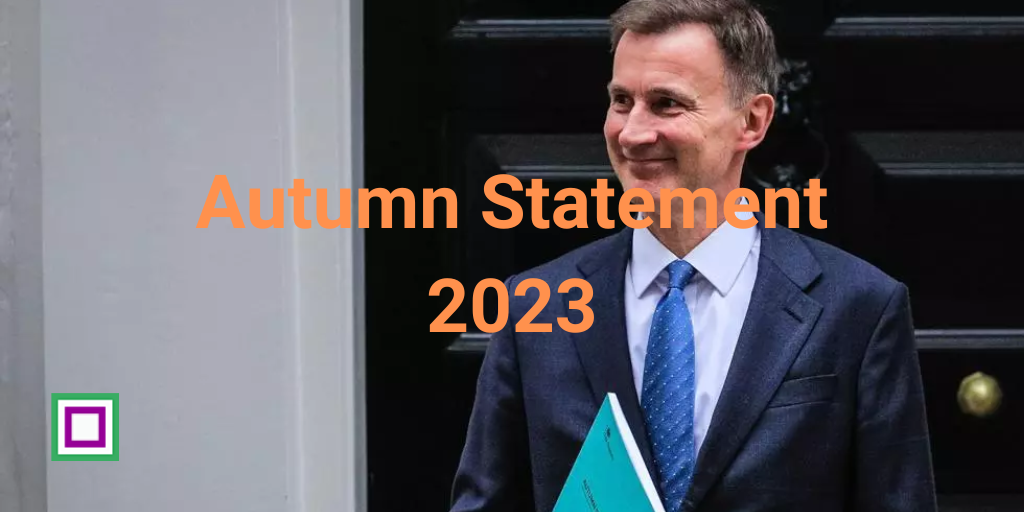
Here’s how the Autumn Statement will affect personal and payroll matters (assuming that it all comes into being):
Headline announcements
- Taxation & wages for salaried people.
The headline policy this year has been the Chancellor, Jeremy Hunt’s decision to cut the main rate of Class 1 employee NICs from 12% to 10% starting on 6th January 2024. According to Gov.uk this will mean that the average worker on £35,400 will have a reduction of contributions in 2024 – 25 of over £450.
- Taxation & wages for the self-employed.
There have been two changes to NIC contributions for the self-employed:
- Class 2 self-employed NICs will be abolished from 6th April 2024.
- From 6th April 2024, self-employed people with profits above £12,570 will no longer be required to pay Class 2 NICs, but will continue to receive access to contributory benefits, including the State Pension.
- Those with profits between £6,725 and £12,570 will continue to get access to contributory benefits including the State Pension through a National Insurance credit without paying NICs as they do currently.
- Those with profits under £6,725 and others who pay Class 2 NICs voluntarily to get access to contributory benefits including the State Pension, will continue to be able to do so.
- The main rate of Class 2 NICs is usually uprated by Consumer Price Index (CPI) and therefore had been due to rise to £3.70 per week in April 2024. For those paying voluntarily, the government has decided to maintain the current rate of £3.45 per week for 2024-25.
- The main rate of Class 4 self-employed NICs will be cut from 9% to 8% on 6th April 2024.
- Tax thresholds
There was no mention of raising the thresholds that taxes start, which have remained the same since the 21 -22 tax year (they used to rise each year). The chancellor said that they would remain unchanged until April 2028. This will mean that as wages rise, more people will be drawn into paying tax for the first time or will go into the higher tax bracket. This is the ‘Fiscal Drag’ that has been mentioned by commentators.
- Minimum wage
There is good news for those on the National Living Wage which will increase to £11.44 per hour and will include those aged 21 and over (previously it was for those 23 and over).
- The Workplace & State Pensions
There will be consultation on whether savers get the right to pick the pension scheme their employer pays into. This may allow them to have one pension pot for life, although currently an employee may already transfer contributions in from another pension.
The full state pension will increase by 8.5%.
- Other measures
Fuel duty was not mentioned and so remains the same.
Taxes on tobacco will increase by 2% above RPI (12% above RPI for hand rolling tobacco).
All alcohol duty will remain frozen until 1st August 2024.
Detailed thresholds for Tax year 2023 – 24
- Tax thresholds
As above, there was no mention of raising the thresholds that taxes start, which have remained the same since the 21 -22 tax year (they used to rise each year). The chancellor said that they would remain unchanged until April 2028. This
The Personal Allowance remains at £12,570 per annum, meaning that no tax is paid on wages up to this figure, £1,048 per month or £242 per week.
There are three tax bands for earnings above £12,570:
Basic Rate 20% on £1 – £37,700 (i.e. for total earnings £12,571 – £37,700)
Higher Rate 40% on £37,701 – £125,140 and
Additional Rate 45% on £125,141 and above.
- New tax codes
Form P9X (2023) from HMRC gives the tax codes to use from 6th April 2023.
The codes remain the same as the previous tax year.
- National Insurance
As detailed above, the Class 1 National Insurance rate has reduced with the thresholds remaining the same as the second half of 2022.
The lower earnings limit (LEL) is the point at which you can claim qualifying years for the state pension but NI rate is 0%. For 2023 – 24 it is £9,100 per year. If you employ someone and pay them this amount or more you have to register for PAYE.
The Primary Threshold is where the employee starts paying NI and the Secondary Threshold is where the employer starts paying NI.
The bands are:
| Threshold | Pay per week | Pay per month | Pay per annum | Rate (category letter A) |
| Lower earnings limit (LEL) | £123 | £533 | £6,396 | 0% |
| Primary Threshold (PT) | £242 | £1,048 | £12,570 | 12% |
| Secondary Threshold (ST) | £175 | £758 | £9,100 | 12% |
| Upper Secondary Threshold (under 21) (UST) | £967 | £4,189 | £50,270 | 2% |
| Apprentice UST (AUST) | £967 | £4,189 | £50,270 | 2% |
| Upper Earnings Limit (UEL) | £967 | £4,189 | £50,270 | 2% |
Employers National Insurance (for category letter A) is 0.00% for earnings at or above LEL up and including ST.
For earnings above ST up to and including UEL/ UST/ AUST, it is 13.80%
The Employers National Insurance Allowance remains at £4,000 per year. You are only eligible if your total Class 1 NICs liability is below £100,000 in the tax year before the year of claim. It will also start to operate as de minimis state aid.
- National Minimum Wage
The national minimum wage goes up on 1st April:
| Year | 23 and over | 21 to 22 | 18 to 20 | Under 18 | Apprentice |
| April 2023 (current rate) | £10.42 | £10.18 | £7.49 | £5.28 | £5.28 |
| April 2024 | £11.44 | £11.44 | £8.60 | £6.40 | £6.40 |
| Increase | 8.9% | 11.0% | 12.9% | 17.5% | 17.5% |
Almost all workers are entitled to it by law. The BBC included the above breakdown.
- The Workplace Pension
As mentioned above, there will be consultation on whether savers get the right to pick the pension scheme their employer pays into.
The contribution rates for both employers and employees remain the same. There are currently no plans for future increases.
Auto-enrolment occurs when a worker is between 22 and State Pension age and earns at least £10,00 per year.
The employer’s contribution is 3.0% and
The employee’s contribution is 5.0%.
This gives a minimum total of 8.0%. However, should the employer pay more, say 4.0% then the employee, should they wish, could pay less, say 4.0% and still maintain the 8.0% minimum. Both employer and employee can pay more than the minimum.
- Statutory Sick Pay (SSP)
This was not mentioned and currently remains at £109.40 per week. The first 3 days of any sick leave remain as ‘qualifying days’.
Hopefully this has been of use as a checklist of things to do. It is not comprehensive and you should check on maternity & paternity pay, student loans, etc. as appropriate.



